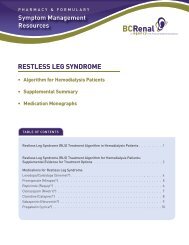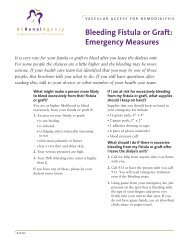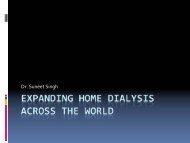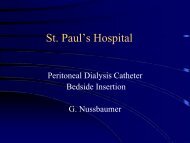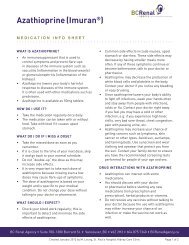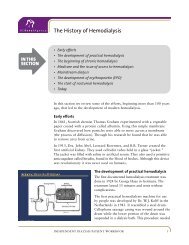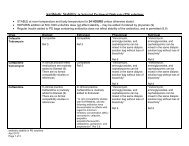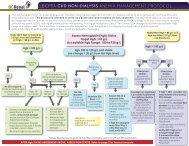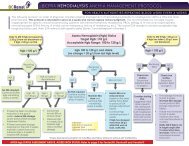Dialysis Water Equipment Monitoring - BC Renal Agency
Dialysis Water Equipment Monitoring - BC Renal Agency
Dialysis Water Equipment Monitoring - BC Renal Agency
Create successful ePaper yourself
Turn your PDF publications into a flip-book with our unique Google optimized e-Paper software.
Clinical Practice Standards and Procedures for<br />
<strong>Dialysis</strong> <strong>Water</strong> Quality:<br />
6: <strong>Dialysis</strong> <strong>Water</strong> <strong>Equipment</strong> <strong>Monitoring</strong><br />
Section: HD Origin Date: November 2011<br />
Reviewed Date: November 2011<br />
PRINTED copies of Clinical Practice Standards and Procedures may not be the most recent version.<br />
The most current version is located on the <strong>BC</strong>PRA Website (www.bcrenalagency.ca)<br />
1.0 PRACTICE STANDARD<br />
1.1. Purpose<br />
The Biomedical Technologist, <strong>Renal</strong> <strong>Dialysis</strong> Technician, or <strong>Renal</strong> Nurse who is trained and has<br />
demonstrated competency in dialysis water practices will use the procedure outlined in this document to<br />
conduct performance checks on the dialysis water equipment and treatment system. It is important to<br />
note that not all equipment mentioned in this standard may be applicable to or present at the respective<br />
<strong>Renal</strong> Unit.<br />
1.2. Standards<br />
The manufacturer recommendations and instructions should always be followed first.<br />
The following parameters must be monitored continuously with audible and/or visible alarms:<br />
Parameter<br />
Alarm Limit<br />
DI tanks<br />
> 1 MΩ∙cm<br />
RO incoming water pressure<br />
Manufacturr specific<br />
RO incoming water temperature 25 °C ± 2°C<br />
RO conductivity<br />
< 15 mS/cm<br />
RO percent rejection > 90 %<br />
There are certain important parameters that must be checked daily. If any problems are detected,<br />
Biomedical Engineering must be contacted. The <strong>Renal</strong> <strong>Dialysis</strong> Tech or <strong>Renal</strong> Nurse must check daily:<br />
Incoming water temperature (approx. 25°C ± 2°C).<br />
<br />
<br />
<strong>Water</strong> leaks as indicated by drips from fittings or water on the floor.<br />
Pressure drop across multi-media sediment filter, water softener, carbon tanks, DI tanks (if<br />
applicable), and endotoxin ultra-filter by measuring the inlet and outlet pressure gauges on<br />
the water lines (pressure drop changes should remain less than 10 PSI from baseline).<br />
Biomedical Engineering will check all water treatment operating parameters, which may vary at sites with<br />
<strong>Renal</strong> <strong>Dialysis</strong> Technicians. In addition to the daily checks, Biomedical Engineering must check monthly:<br />
<br />
<br />
<br />
<br />
<br />
<br />
<br />
<br />
RO operational parameters, including pressures, temperatures, and water quality.<br />
DI operational parameters.<br />
Sediment filter backwash cycle timer setting.<br />
Carbon regeneration timer setting.<br />
<strong>Water</strong> softener effluent water hardness (less than 1 GPG, or 17.2 PPM).<br />
Brine tank salt level (at least half the tank and no salt bridge).<br />
Softener regeneration timer setting.<br />
For portable ROs, carbon filters should be changed.<br />
2.0 DEFINITIONS AND ABBREVIATIONS
DI<br />
<strong>Dialysis</strong> water<br />
EDTA<br />
GPG<br />
Hemodialysis<br />
Percent rejection<br />
Product water<br />
PSI<br />
RO<br />
Salt Bridge<br />
TDS<br />
<strong>Water</strong> treatment system<br />
Deionization.<br />
<strong>Water</strong> that has been treated to meet the requirements of the CSA-ISO<br />
standards and which is suitable for use in hemodialysis applications,<br />
including the preparation of dialysis fluid, reprocessing of dialysate,<br />
preparation of concentrates and preparation of substitution fluid for online<br />
convective therapies.<br />
Ethylenediaminetetraacetic acid.<br />
<strong>Water</strong> hardness unit; grains per gallon.<br />
Form of renal replacement therapy in which waste solutes are removed<br />
primarily by diffusion from blood flowing on one side of a membrane into<br />
dialysis fluid flowing on the other side.<br />
Measurement of rejection of solutes by RO membrane and, thus,<br />
measurement of equipment performance.<br />
<strong>Water</strong> produced by a water treatment system or individual component<br />
thereof.<br />
Pressure unit; pounds per square inch.<br />
Reverse osmosis.<br />
Where salt at the top of the tank solidifies, making it appear as though the<br />
tank is full when it is actually empty underneath.<br />
Total dissolved solids.<br />
Collection of water treatment devices and associated piping, pumps, valves,<br />
gauges, etc., that together produce treated water for hemodialysis<br />
applications and deliver it to the point of use.<br />
Disclaimer: The procedure steps may not depict actual sequence of events. Site-specific considerations may be<br />
made when applying the following procedures and protocols.<br />
3.0 EQUIPMENT<br />
EDTA titration test kit (optional)<br />
Dip-and-read test strips (optional)<br />
Daily <strong>Dialysis</strong> <strong>Water</strong> <strong>Equipment</strong> <strong>Monitoring</strong> Log Sheet<br />
Monthly <strong>Dialysis</strong> <strong>Water</strong> <strong>Equipment</strong> <strong>Monitoring</strong> Log Sheet<br />
4.0 DAILY MONITORING PROCEDURE<br />
4.1 Check the incoming water temperature.<br />
4.1.1 If the temperature is not 25°C ± 2°C, contact Biomed to adjust the blending valve.<br />
4.2 Look around the RO system for any visible fluid leaks.<br />
4.2.1 If any leaks are observed, contact Biomedical Engineering.<br />
4.3 Check and record the pressure gauge prior to the multi-media sediment filter.<br />
4.4 Check and record the pressure gauge prior to each of the carbon tanks.<br />
4.4.1 Record the pressure before the primary carbon tank.<br />
4.4.2 Record the pressure before the polisher carbon tank.<br />
4.5 Check and record the pressure gauge prior to the water softener.<br />
4.6 Check and record the pressure gauge prior to the RO.
4.7 Check and record the pressure gauge prior to each of the DI tanks, if pressure gauges are<br />
present.<br />
4.8 Look over all recorded pressures. If any of the pressure changes are greater than 10 PSI from<br />
baseline, contact Biomed immediately.<br />
4.9 Check the pressure across the endotoxin ultra-filter.<br />
4.9.1 Measure and record the pressures before and after the endotoxin filter.<br />
4.9.1.1 Calculate and record the pressure change across the filter.<br />
4.9.1.2 If the change in pressure is greater than 10 PSI from baseline, contact Biomed<br />
to replace the filter cartridges.<br />
4.10 Record all checks, including time and initials, on the Daily <strong>Dialysis</strong> <strong>Water</strong> <strong>Equipment</strong> <strong>Monitoring</strong><br />
Log Sheet.<br />
5.0 MONTHLY MONITORING PROCEDURE<br />
5.1 Check the incoming water temperature.<br />
5.1.1 If the temperature is not 25°C ± 2°C, adjust the blending valve accordingly.<br />
5.2 Look around the RO system for any visible fluid leaks.<br />
5.3 Check the RO.<br />
Note: The microbiological, chemical, and chlorine testing of feed water to or dialysis water from<br />
the RO are covered in the Microbial Testing of <strong>Dialysis</strong> <strong>Water</strong>, Endotoxin Testing of <strong>Dialysis</strong><br />
<strong>Water</strong>, Chemical Analyses of <strong>Dialysis</strong> <strong>Water</strong>, and Daily Chlorine Testing of <strong>Dialysis</strong> <strong>Water</strong> clinical<br />
standards.<br />
5.3.1 Measure and record the pressures before and after the pre-filter.<br />
5.3.1.1 Calculate and record the pressure change across the pre-filter.<br />
5.3.1.2 If the change in pressure is greater than 10 PSI from baseline, replace the filter<br />
cartridge.<br />
5.3.2 Measure and record the pressures before and after the RO membrane.<br />
5.3.2.1 Calculate and record the pressure change across the pre-filter.<br />
5.3.2.2 If the change in pressure is greater than 10 PSI from baseline, the RO<br />
membranes should be cleaned. If cleaning fails to restore performance, the<br />
membrane modules might need to be replaced.<br />
5.3.3 Check and record the pump, reject, and product pressures.<br />
5.3.4 Check and record the recycle, waste, and permeate flowrates.<br />
5.3.5 Check and record the inlet and permeate conductivities. Read the RO monitor and record<br />
the conductivity and percent rejection.<br />
5.3.5.1 If the conductivity is less than 15 mS/cm, perform chemical analyses for<br />
contaminants in the water. (Refer to the Chemical Analyses of <strong>Dialysis</strong> <strong>Water</strong><br />
clinical standard.)<br />
5.3.6 Check and record the percent rejection.<br />
5.3.6.1 If the percent rejection is less than 90%, perform chemical analyses for<br />
contaminants in the water. (Refer to the Chemical Analyses of <strong>Dialysis</strong> <strong>Water</strong><br />
clinical standard.)<br />
5.3.7 Check and record the pump run hours.<br />
5.4 Check the multi-media sediment filter.<br />
5.4.1 Measure and record the pressures before and after the multi-media filter.<br />
5.4.1.1 Calculate and record the pressure change across the multi-media filter.<br />
5.4.1.2 If the change in pressure is greater than 10 PSI from baseline, troubleshoot and
eplace the cartridge, or, if necessary, perform disinfection. (Refer to the<br />
Cleaning and Disinfection of <strong>Dialysis</strong> <strong>Water</strong> <strong>Equipment</strong> clinical standard).<br />
5.4.2 Check and record the setting for the backwash cycle timer.<br />
5.5 Check the primary and polisher carbon tanks.<br />
5.5.1 Measure and record the pressures before and after each carbon tank.<br />
5.5.1.1 Calculate and record the pressure change across each of the carbon tanks.<br />
5.5.1.2 If the change in pressure is greater than 10 PSI from baseline for either of the<br />
carbon tanks, troubleshoot and replace the tank(s), or, if necessary, perform<br />
disinfection. (Refer to the Cleaning and Disinfection of <strong>Dialysis</strong> <strong>Water</strong><br />
<strong>Equipment</strong> clinical standard).<br />
5.5.2 Check and record the settings for the carbon regeneration timers on the primary carbon<br />
tank and on the polisher carbon tank. The timers should be set to activate when the<br />
facility is not operating.<br />
5.6 Check the water softener.<br />
5.6.1 Measure and record the pressures before and after the water softener.<br />
5.6.1.1 Calculate and record the pressure change across the water softener.<br />
5.6.1.2 If the change in pressure is greater than 10 PSI from baseline, check that the<br />
regeneration timer is at the proper setting.<br />
5.6.2 Check and record the setting for the regeneration timer. The timer should be set to<br />
activate when the facility, especially the RO, is not operating.<br />
5.6.3 Check the brine tank.<br />
5.6.3.1 Look for the presence of a salt bridge, where salt at the top of the tank solidifies,<br />
making it appear as though the tank is full when it is actually empty underneath.<br />
5.6.3.2 Check and record whether the salt pellets fill at least half the tank (or as<br />
recommended by the manufacturer). Rock salt should not be used for water<br />
regeneration since it is not refined and typically contains sediments and other<br />
impurities that may damage other components of the water softener.<br />
5.6.4 Test for total hardness.<br />
5.6.4.1 Collect a sample of water at the water softener output.<br />
5.6.4.2 Use an EDTA test or dip-and-read test strips to test for total hardness by<br />
measuring the calcium carbonate concentration.<br />
5.6.4.3 Record the total hardness measured.<br />
5.6.4.4 If the total hardness is greater than 1 GPG of calcium carbonate (or the limit<br />
established by the manufacturer), troubleshoot the water softener for proper<br />
operation.<br />
5.7 Check the DI tanks.<br />
5.7.1 If available, measure the pressures before and after each DI tank.<br />
5.7.1.1 Calculate the pressure changes across each DI tank.<br />
5.7.1.2 If the change in pressure is greater than 10 PSI from baseline for either of the DI<br />
tanks, this could indicate that the tanks are becoming plugged with particulate<br />
matter, or that resin is potentially breaking down and restricting the flow of<br />
water. Troubleshoot and, if necessary, replace the tanks.<br />
5.7.2 Check and record whether the resistivity of each of the DI tanks is greater than 1 MΩ·cm.<br />
5.8 Check the endotoxin ultra-filter.<br />
5.8.1 Measure and record the pressures before and after the endotoxin filter.<br />
5.8.1.1 Calculate and record the pressure change across the endotoxin filter.<br />
5.8.1.2 If the change in pressure is greater than 10 PSI from baseline, troubleshoot and
eplace cartridge, or, if necessary, perform disinfection. (Refer to the Cleaning<br />
and Disinfection of <strong>Dialysis</strong> <strong>Water</strong> <strong>Equipment</strong> clinical standard).<br />
5.9 For portable ROs, change the carbon filters.<br />
5.10 Record all checks, including date, time, and initials, on the Monthly <strong>Dialysis</strong> <strong>Water</strong> <strong>Equipment</strong><br />
<strong>Monitoring</strong> Log Sheet.<br />
6.0 DOCUMENTATION CONSIDERATIONS<br />
All daily and monthly monitored parameters must be recorded on the Daily <strong>Dialysis</strong> <strong>Water</strong> <strong>Equipment</strong><br />
<strong>Monitoring</strong> Log Sheet and Monthly <strong>Dialysis</strong> <strong>Water</strong> <strong>Equipment</strong> <strong>Monitoring</strong> Log Sheet, respectively. The log<br />
sheets must be reviewed by the Area <strong>Renal</strong> Manager semi-annually.<br />
7.0 SPECIAL CONSIDERATIONS<br />
<br />
<br />
<br />
<br />
Newer RO systems may have a direct reading for percent rejection.<br />
Baseline pressure readings should be noted on the filter at the time of installation.<br />
Deionizers must be monitored continuously using resistivity monitors that compensate for temperature<br />
and are equipped with audible and visual alarms.<br />
When choosing a test method for testing for water hardness, the user should ensure that the test<br />
accuracy and sensitivity are sufficient to satisfy the total hardness monitoring requirements of the RO<br />
machine manufacturer.<br />
8.0 REFERENCES<br />
<br />
<br />
CAN/CSA-ISO 26722-11 – <strong>Water</strong> treatment equipment for hemodialysis applications and related<br />
therapies (Adopted ISO 26722:2009, First edition, 2009-04-15), Canadian Standards Association,<br />
2011.<br />
Dialysate for hemodialysis (ANSI/AAMI RD52:2004/(R)2010), Association for the Advancement for<br />
Medical Instrumentation, Arlington (VA), 2009.<br />
<strong>Monitoring</strong> Your <strong>Dialysis</strong> <strong>Water</strong> Treatment System, Northwest <strong>Renal</strong> Network, June 2005.<br />
Richard A. Ward, Maintaining water quality for hemodialysis, UpToDate, Jan. 2011.<br />
9.0 DEVELOPED BY<br />
Janise Galvey, Manager, IH Biomedical Engineering<br />
Provincial revisions - Dr. Myriam Farah<br />
10.0 REVIEWED BY<br />
IH <strong>Renal</strong> Biomedical Technologists and <strong>Renal</strong> Program Technicians and Managers<br />
NHA <strong>Renal</strong> Biomedical Technologists and <strong>Renal</strong> Program Technicians and Managers<br />
FHA <strong>Renal</strong> Biomedical Technologists and <strong>Renal</strong> Managers<br />
VIHA <strong>Renal</strong> Biomedical Technologists and <strong>Renal</strong> Managers<br />
PHC <strong>Renal</strong> Biomedical Technologists and <strong>Renal</strong> Managers<br />
11.0 ENDORSED BY<br />
<strong>BC</strong> Provincial Task Force for <strong>Dialysis</strong> <strong>Water</strong> Quality:<br />
Dr. Sue Bannerman<br />
Dr. Michael Copland<br />
Dr. Gerry Karr<br />
Dr. Myriam Farah
Tim Rode<br />
Edith Davidson<br />
12.0 APPROVED BY<br />
<strong>BC</strong>PRA Medical Advisory Council – November 2011




